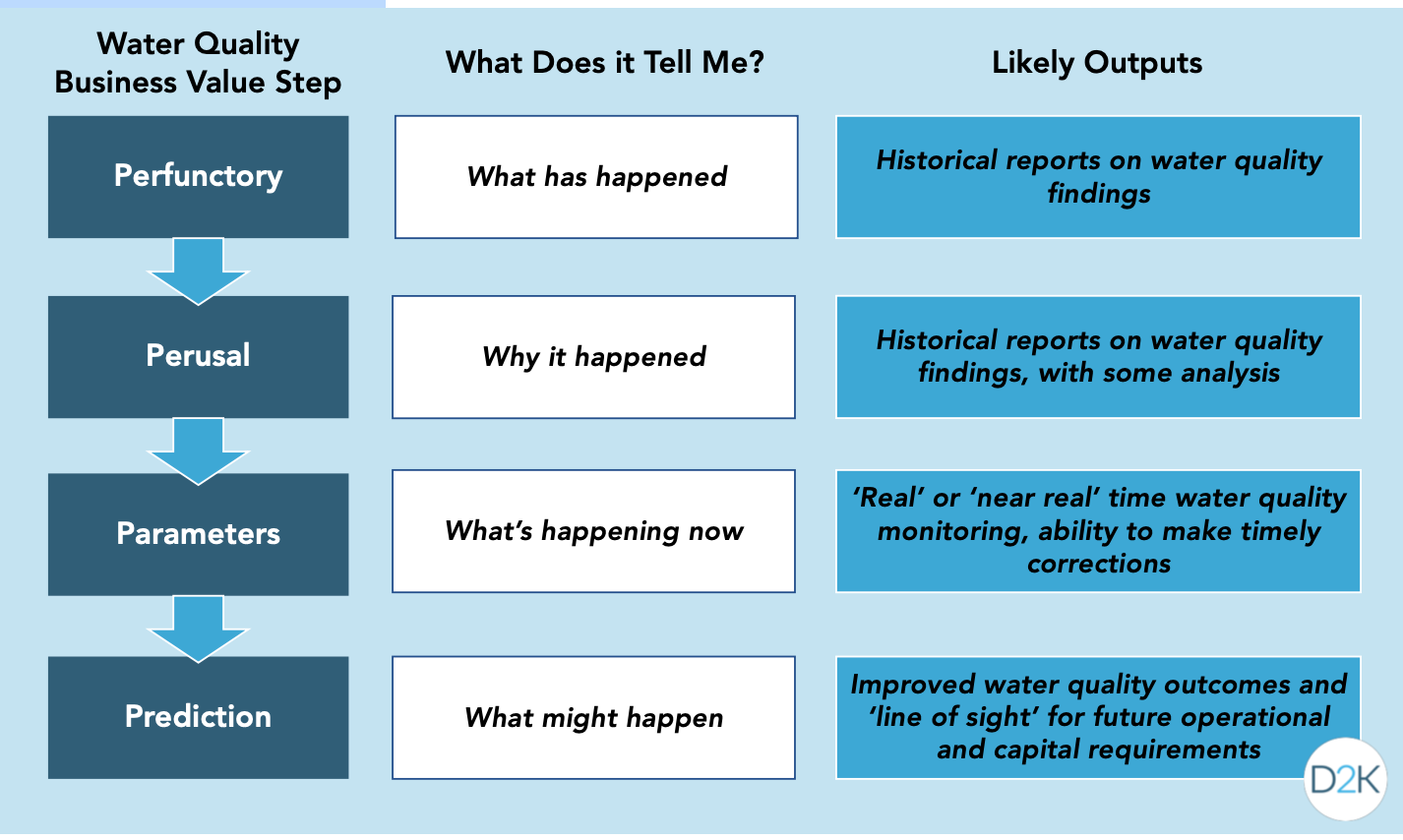 The Framework for Management of Drinking Water Quality (Australian Drinking Water Guidelines) includes several requirements for water supply system monitoring. You’ve been collecting water quality data for years. You will be doing compliance reporting. You will probably be doing some short-term trending analysis. You might be doing long-term trending analysis.
The Framework for Management of Drinking Water Quality (Australian Drinking Water Guidelines) includes several requirements for water supply system monitoring. You’ve been collecting water quality data for years. You will be doing compliance reporting. You will probably be doing some short-term trending analysis. You might be doing long-term trending analysis.
But are you scrutinizing the data to improve your water quality business performance?
How can you increase your line of sight for capital and operational improvements?
How can you unlock the value from your water quality data?
Here we look at the four ‘P’s’ of the journey to better water quality management – perfunctory, perusal, parameters and prediction.
Perfunctory
You might have been collecting water quality data at the same points in the system for years, you have been going through the motions for compliance reporting. Your workload is hampering your thought processes on the data you are collecting and how those data might provide value. You are reporting on your findings but this approach just provides you with information on the water quality you have already provided – it is historical – it tells you ‘what has happened’. It is better than nothing at all but it is a perfunctory approach.
What can you do better?
Perusal
The next leap forward is perusal of the water quality data. What types of data analysis should you do to glean some information and understand ‘why did it happen’? The Framework states that you should be undertaking short and long-term trending analysis of your water quality data sets. Operators are hard-pressed undertaking the day to day work they have to do, so water quality data analysis (other than perusing SCADA records) is often of lower priority. Manually analyzing mountains of data through spreadsheets is not the most exciting of things to do and is fraught with pitfalls. How often has your spreadsheet been reading the wrong cell or the dataset is just so big that Excel grinds to a halt? Also, in today’s modern utility, how can you integrate the different databases so you can start to make sense of multiple datasets that might provide business insights in ways that you have not thought about previously? Getting the parameters right is the next step.
Parameters
Monitoring is an important part of the whole picture, but what should you be monitoring? When was the last time you took a long hard look at your monitoring program? Is it time to pick it up and give it some heavy scrutiny? Are the correct parameters being monitored, at the right locations at the right frequencies, to give you good information? Things might have changed, are there newer, perhaps more innovative ways of monitoring and transmitting water quality that you are not taking advantage of? It is useful to review parameters other than typical water quality data parameters, such as rainfall and stream flow, which can provide good information on the ‘riskiness’ of a water source and potential impacts on treatment. Customer complaints can also be the ‘canary in the coalmine’ – quickly being able to trend these data and compare with other water quality information is invaluable.
Undertaking an audit of how you go about monitoring will improve your understanding of ‘what’s happening now’. Don’t just keep going because ‘that’s what we’ve always done’.
Prediction
The icing on the cake is prediction – ‘what might happen’. Managers, board directors, customers and shareholders don’t want surprises. They want better water quality data information, earlier. Price paths for capital expenditure can take years. Increasing the line of sight for capital requirements such as asset replacement, can align budgets with pre-failure timing. Imagine having the budget ready to go rather than hanging around waiting for budget to be approved, with failed, non-revenue, assets in the ground?
Utilities often have tight operational budgets. Predicting where operational improvements can be made can assist with operational budgeting and expenditure, increasing return on investment and improving water quality data compliance outcomes. A win for everyone.
Utilities that get value from their data run better businesses for their customers, have improved return on investment and have better water quality outcomes.
Perfunctory or predictive – which type of utility are you?
Welcome to D2K. We are a start-up specialist water quality monitoring technology and information provider. We profoundly know water. Our aim is to provide well-designed and executed water quality monitoring, information and system optimisation solutions. Learn more here.
(C) Annette Davison – originally published with permission at d2kinformation.com
Bios:
Annette Davison
Annette is a sought-after risk and auditing expert, with over 30 years’ experience in the industry, having worked for a range of companies and regulators. Annette holds three degrees (BSc(Hons), MEnvLGovLaw and a PhD) and has a background in microbiology and environmental law. She is the director and founder of two companies, Risk Edge Pty Ltd and the water quality monitoring and information start-up, D2K Information Pty Ltd.
E: annette@riskedge.com.au or annette@d2kinformation.com
M: +61 411 049 544
W: riskedge.com.au or d2kinformation.com
